Summary: Euro-zone household pessimism improves in June; consumer confidence index still well below long-term average, lower bound of “normal” readings; euro-zone yields increase materially.
EU consumer confidence plunged during the GFC and again in 2011/12 during the European debt crisis. After bouncing back through 2013 and 2014, it fell back significantly in late 2018 but only to a level which corresponds to significant optimism among households. Following the plunge which took place in April 2020, a recovery began a month later, with household confidence returning to above-average levels from March 2021. However, readings subsequent to early 2022 were extremely low by historical standards until just recently.
Consumer confidence improved modestly in June according to the latest survey conducted by the European Commission. Its Consumer Confidence Indicator recorded a reading of -16.1, above the generally expected figure of -17.0 as well as May’s -17.4. This latest reading is still well below the long-term average of -10.4 and outside the lower end of the range in which “normal” readings usually occur.
Sovereign bond yields in major euro-zone bond markets increased materially on the day. By the close of business, the German 10-year bund yield had gained 5bps to 2.148% while the French 10-year OAT yield finished 7bps higher at 3.02%.


